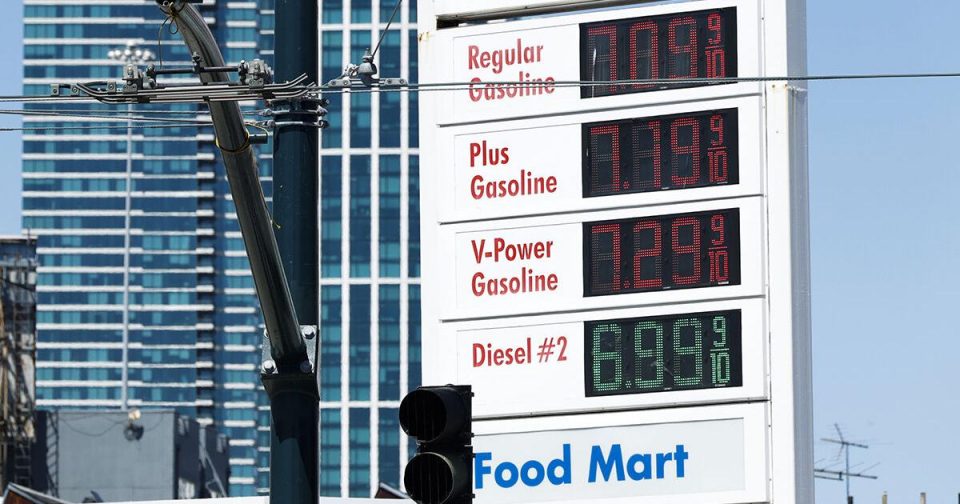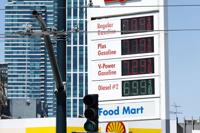Gas prices were above $7 a gallon at a Shell station at Fourth and Bryant streets early last week.
These days, it feels like The City’s electric car owners cruise past gas stations with a certain smugness. Seven dollars per gallon? Not their problem.
But if you depend on a gas-powered vehicle to get around, you are undoubtedly feeling pain at the pump. This week, the national average for a gallon of regular gasoline increased by 11 cents to $4.97 — a 62% increase from this time last year, according to new data from the Energy Information Administration.
Even before the Russian invasion of Ukraine touched off a global energy crisis, California already had some of the highest gas prices in the nation due to a confluence of factors, including a statewide requirement to limit harmful pollutants spewing from tailpipes. Yet this fact may offer little solace when supply chains are stressed, inflation is spiking, interest rates are on the rise and anxiety about an economic downturn hangs thick in the air.
“I am certainly looking every time I pull up at the gas station,” said Maximilian Auffhammer, a professor of international sustainable development and environmental economist at the University of California Berkeley.
So, as gas prices surge, are more people switching to electric vehicles to avoid the pinch at the pump? Or are pandemic-related supply chain headaches getting in the way?
“It doesn’t matter whether you want to buy an EV or a regular car. Trying to buy a car right now — used or new — it’s hard, and it’s really expensive,” said Auffhammer. “But we’re certainly seeing people who thought about eventually wanting to make the switch (to an EV), saying, I want to make the switch now.”
It’s a reality that keeps Nathan Wyeth, founder of Link, a Bay Area-based startup that helps guide customers through purchasing an EV, very busy these days. “There’s not one type of car shopper or one type of driver thinking about electric,” said Wyeth. “And as gas prices rise, that has added even more demand and, I think, urgency for some people.”
You don’t have to look further than the lineup of this year’s Super Bowl commercials to see the groundswell of consumer interest and industry investment swirling around electrification.
“This is, for sure, the decade of the electric vehicle,” said Russell Hensley, who co-leads the Center for Future Mobility at the consulting firm McKinsey & Co.
Gone are the days when electric cars were reserved for techies or Birkenstock-clad environmentalists who sought out the first Teslas or hummed around town in Priuses. “We are beyond that now,” said Hensley. “The vehicle that you used to have, that you liked the utility of it or the shape of it, you can now get to the EV equivalent, whereas previously you couldn’t.”
Electrified cars of all makes and models are coming online at a rapid clip, from mid-size sedans like the Audi E-tron or the Kia EV-6 to heavy-haulers like Ford F150s and Rivian SUVs — at least in theory. While experts agree that the demand has skyrocketed, delivery of these cars may still be out of reach.
“Depending on the model, it can be really challenging right now,” said Wyeth. “We wish we could snap our fingers and create cars out of thin air, but unfortunately, we can’t.”
The EV shortage is just one example of how the pandemic has disrupted the global economy. “If I went out today and tried to buy an EV, the supply would be somewhat limited because we’ve had COVID where we’ve had massive fluctuations in workforce availability — and we’ve had a chip shortage, which isn’t something that goes away overnight,” said Hensley.
But experts agree that fuel prices and supply chain issues represent a short-term hiccup in a long tailwind of mushrooming momentum. “If you talk to manufacturers these days, it’s all about how can we produce more models? How can we produce more of these vehicles?” said Auffhammer.
Research shows that while owning or leasing an EV is cheaper in the long run — even in a place like California, where the cost of electricity is also high — the upfront cost of EVs generally remains higher than gas-powered cars, which can make these cars inaccessible for some.
“It’s similar to when you’re thinking about buying a laser printer or buying an inkjet,” said Aufhammer. “Inkjet printers are cheaper to buy, but you’re going to pay so much more for cartridges versus for the laser printer.”
Despite this, Hensley thinks that the upfront price discrepancy is another issue that will soon sort itself. “You probably get to a standard, an equivalence point in the next two to three years,” he said, making EVs comparable to combustion engines, just without the need for gas stations, oil changes or filter swaps.
And, he added, that once people go electric, they stay electric. “Once people have experienced the driving experience, whether it be the acceleration, whether it be the refinement because you don’t have the engine noise — they absolutely love them,” he said. “People who have owned electric vehicles — they don’t go back to internal combustion.”



